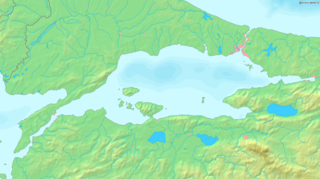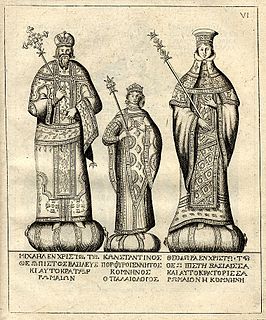Manuel Holobolos (Greek : Μανουὴλ Ὁλόβολος; ca. 1245 – 1310/14) was a Byzantine orator and monk, who was a leading opponent of the Union of the Churches in the reign of Michael VIII Palaiologos (r. 1259–1282).

Greek is an independent branch of the Indo-European family of languages, native to Greece, Cyprus and other parts of the Eastern Mediterranean and the Black Sea. It has the longest documented history of any living Indo-European language, spanning more than 3000 years of written records. Its writing system has been the Greek alphabet for the major part of its history; other systems, such as Linear B and the Cypriot syllabary, were used previously. The alphabet arose from the Phoenician script and was in turn the basis of the Latin, Cyrillic, Armenian, Coptic, Gothic, and many other writing systems.

The Second Council of Lyon was the fourteenth ecumenical council of the Catholic Church, convoked on 31 March 1272 and convened in Lyon, Kingdom of Arles, in 1274. Pope Gregory X presided over the council, called to act on a pledge by Byzantine emperor Michael VIII to reunite the Eastern church with the West. The council was attended by about 300 bishops, 60 abbots and more than a thousand prelates or their procurators, among whom were the representatives of the universities. Due to the great number of attendees, those who had come to Lyon without being specifically summoned were given "leave to depart with the blessing of God" and of the Pope. Among others who attended the council were James I of Aragon, the ambassador of the Emperor Michael VIII Palaiologos with members of the Greek clergy and the ambassadors of Abaqa Khan of the Ilkhanate. Thomas Aquinas had been summoned to the council, but died en route at Fossanova Abbey. Bonaventure was present at the first four sessions, but died at Lyon on 15 July 1274. As at the First Council of Lyons Thomas Cantilupe was an English attender and a papal chaplain.

Michael VIII Palaiologos or Palaeologus reigned as the co-emperor of the Empire of Nicaea from 1259 to 1261, and as Byzantine Emperor from 1261 until his death. Michael VIII was the founder of the Palaiologan dynasty that would rule the Byzantine Empire until the Fall of Constantinople in 1453. He recovered Constantinople from the Latin Empire in 1261 and transformed the Empire of Nicaea into a restored Byzantine Empire.
Born ca. 1245, Holobolos entered the service of Michael VIII as a grammatikos in his teens, and composed several orations for the early years of Michael's reign that are an important primary source. In 1261, however, when Michael ordered the blinding and imprisonment of the legitimate emperor, John IV Laskaris (r. 1258–1261), Holobolos expressed public grief, and his lips and nose were mutilated as punishment. Holobolos then retired from public service and became a monk at the Prodromos Monastery in Constantinople, with the monastic name Maximos.

Mutilation in the Byzantine Empire was a common method of punishment for criminals of the era but it also had a role in the empire's political life. Some disfigurements practised bore a secondary practical rationale as well. By blinding a rival, one would not only restrict their mobility but make it almost impossible for them to lead an army into battle, then an important part of taking control of the empire. Castration was also used to eliminate potential opponents. In the Byzantine Empire, for a man to be castrated meant that he was no longer a man—half-dead, "life that was half death". Castration also eliminated any chance of heirs being born to threaten either the emperor or the emperor's children's place at the throne. Other mutilations were the severing of the nose (rhinotomy) or the amputating of limbs.

John IV Doukas Laskaris was emperor of Nicaea from August 18, 1258, to December 25, 1261. This empire was one of the Greek states formed from the remaining fragments of the Byzantine Empire, after the capture of Constantinople by Roman Catholics during the Fourth Crusade in 1204.

Constantinople was the capital city of the Roman Empire (330–395), of the Byzantine Empire, and also of the brief Crusader state known as the Latin Empire (1204–1261), until finally falling to the Ottoman Empire (1453–1923). It was reinaugurated in 324 from ancient Byzantium as the new capital of the Roman Empire by Emperor Constantine the Great, after whom it was named, and dedicated on 11 May 330. The city was located in what is now the European side and the core of modern Istanbul.
In 1265/66, through the intervention of Patriarch Germanus III, Holobolos was able to get a post as a teacher, possibly at the orphanage of the Church of St. Paul. Because of his fervent anti-Unionism, he was exiled to the Megalou Agrou monastery on the Sea of Marmara in 1273, and was not allowed to return to the capital until after Michael's death, when his son and successor Andronikos II Palaiologos (r. 1282–1328) repudiated the Union. Thus Holobolos participated in the Council of Blachernae in 1285, which formally condemned the Union, and was restored to imperial favour: he received the title of rhetor and became protosynkellos by 1299.

The Sea of Marmara, also known as the Sea of Marmora or the Marmara Sea, and in the context of classical antiquity as the Propontis is the inland sea, entirely within the borders of Turkey, that connects the Black Sea to the Aegean Sea, thus separating Turkey's Asian and European parts. The Bosphorus strait connects it to the Black Sea and the Dardanelles strait to the Aegean Sea. The former also separates Istanbul into its Asian and European sides. The Sea of Marmara is a small sea with an area of 11,350 km2 (4,380 sq mi), and dimensions 280 km × 80 km. Its greatest depth is 1,370 m (4,490 ft).

Andronikos II Palaiologos, usually Latinized as Andronicus II Palaeologus, reigned as Byzantine Emperor from 1282 to 1328. Andronikos' reign was marked by the beginning of the decline of the Byzantine Empire. During his reign, the Turks conquered most of the Western Anatolian territories of the Empire and, during the last years of his reign, he also had to fight his grandson Andronikos in the First Palaiologan Civil War. The civil war ended in Andronikos II's forced abdication in 1328 after which he retired to a monastery.
According to one of his students, George Galesiotes, he continued teaching until his death, sometime between 1310 and 1314.
George Galesiotes was a high-ranking Byzantine official of the Patriarchate of Constantinople who studied under the tutelage of Manuel Holobolos. Upon becoming an official of the Patriarchate, Galesiotes was in charge of the sakellion of the Church from around 1330 and 1346. Along with being a Church official, Galesiotes also became an author of speeches and other works.



